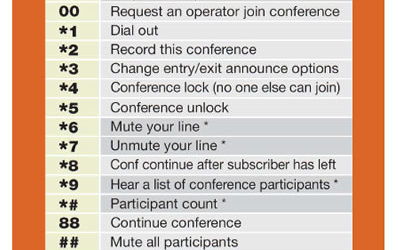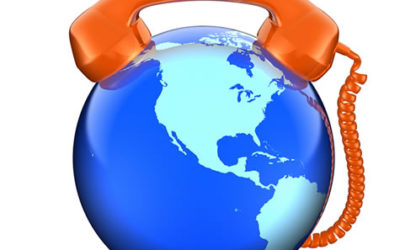Welcome back folks! On Monday we left off talking about how much time can be wasted when your conference calls are not preformed efficiently. Even just getting people on to the call can be a hassle. You may think that a couple minutes here and there don’t really matter much, but they may be costing you more than you think.
Totals
A couple lost moments here and there adds up to an enormous amount of time where if you total everything. If you’re at the lightning fast, VIP account, you may only be spending 15 seconds. Even if you have a call almost every day, call it four times a week, and five people on the call, of course, remember that everybody’s wasting their time, not just you, that doesn’t still add up to even a half an hour. It’s not much.
You contrast that with the other extreme and where people have approximately five man hours of wasted time, if you can believe it. You add it up and that’s what it is. That’s where we’re taking about not just frustration but actual significant loss productivity. Think about what five hours with some of the high-powered people involved and they’re billing rates, what that actually equates to in terms of dollars and cents.
Faster Entry
How can we improve that? Let’s talk about getting a racecar in here. We already mentioned the VIP accounts. That’s going to cut it down entry-wise to only 15 seconds. That is really sweet and something that all of you should think about if you don’t have it already.
Also, we’ll talk about a shorter ID. We mentioned the four digits and customizing that to perhaps your direct extension. Some people may like 10 digits, but for the majority of us 4 digits is going to be much more convenient.
For some of you, you may end up getting a unique ID on every call. That’s absolutely the worst for you and your participants. Certainly, you should expect to have a fixed ID that remains the same not only for the audio portion but also for the web portion so when you log into the web conference. That URL should be the same every time and should take you directly into the conference. But also, you should need and desire to have a very short ID.
Sometimes, you have to enter in a PIN as well. Really, as the host of the call, you don’t want to have to be delayed with having multiple entries that then cause extra time. You can have a call flow where even as a host, you’ve got a unique host ID and the system recognizes you as the host and you still have the security of requiring a host to join the call.
Then, lastly, in terms of faster entry into calls, make sure that your provider allows the operator to put people manually into the call if their ID is not accepted by the system.
All Meetings Are The Same
Let’s move on. All meetings are the same aren’t they? I mean heck you’ve got executive meetings, sales meetings. Tell me what kind of meetings you attend mostly and let me know if you think that they’re the same because we feel they’re very, very different.
A question for you and your provider would be are all of your accounts set up the same? Are the prompts the same? Is the call flow the same? Because if the answer is yes, then you’re really losing out on quite a bit of efficiency because you need to think about what are the different needs for a sales call as opposed to a brainstorming call. Those are entirely different meetings and your tools should help and reduce the overall call time for each of these types of meetings.
Shorter Calls and Optimized Call Flows
Let’s go through it. Here’s a couple of examples, so in one scenario the need might be to record the call and reduce any kind of talk over there might be or people talking over one another. It might be important that the host arrived before the call begins and that for the announcements into the call everybody hears the name of the person joining as well as leaving. Then it might be important to have the call automatically recorded without the host doing anything.
Contrast that with a different type of call and think about as we look at these what type of meeting would benefit because these are portraying two different meetings and I didn’t put the name on there on purpose. I wanted to see if anyone could think about what would apply to what type of meeting. We’ll talk about that afterwards.
Again in contrast, let’s think about a meeting where the need is to summarize all of the information by client and to have very secure confidentiality and security on the call and have actually participant IDs so that you know for sure who’s joining the call. Maybe you also need to have account information and a code assigned to the call and it might be nice to hear everyone’s name as they join but you do anticipate people leaving before the end of the call and you do not want that interruption. You don’t want the system to announce people as they leave.
Two different types of calls and the tool really should be set up quite differently in these two different scenarios. What we’ve got on the top scenario is what we would recommend for a brainstorming call as opposed to the bottom, which would be a client update type of call.
That gives you a sense for some of the things that we’ll optimize for in terms of a trigger for when to start the call, should we wait for the host or not, how can we streamline the different prompts so that the call is not only less intrusive and you don’t have the interruptions but the call flow can be faster. Because again every time there’s a prompt played or an announcement played, that’s going to waste potentially ten to thirty seconds of every single person’s time and that does add up.
Should recording happen automatically or do you only want to record maybe the ten minutes that a summary is taken towards the end? What other additional functions can be turned on?
Conclusion
Well that’s going to wrap up my blog on generic vanilla conferencing. If you have any questions please feel free to reach out to me directly or give the office a call. If you enjoyed this article and want to learn more about how to make the most of your conferences download our guide to the Collaborators Manifesto I have linked to below. If you have questions about audio conferencing, or would like to set up a free trial to test our conferencing solution, visit our free trial page or call 888-55-ADIGO.




0 Comments